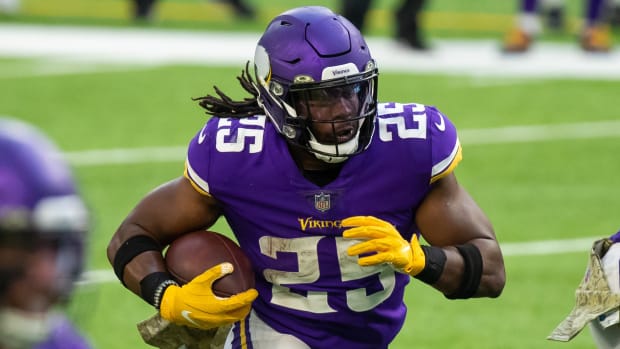The Vikings released Dalvin Cook earlier this month in a cost-cutting move that freed up hundreds of carries. As for Minnesota’s succession plan, Alexander Mattison is stepping into the starting role after spending the first few years of his career as Cook’s backup.
Mattison signed an extension earlier in the offseason when Cook’s future with the team was still in question. Now the fifth year rusher is set to headline the young, inexperienced running back room. Kene Nwangwu, a 2021 fourth-round selection, has 22 career carries; Ty Chandler, a fifth-round pick in 2022, has six; and DeWayne McBride joined from the fray when he was selected in the seventh round in April.
The Vikings’ have 264 vacated carries — all from Cook — which is the fourth-most in the NFL, per 4for4. That total accounts for 74.7% of their running back carries from 2022, the third-highest percentage in the league. Though Cook’s departure is a blow to the offense, Minnesota’s rushing rate dropped precipitously under coach Kevin O’Connell. In 2020, the Vikings ran the ball on over 45% of their plays, the sixth-highest rate. That fell to 36% in 2022, the third-lowest. The focus of this offense is clearly the passing game, with All-Pro receiver Justin Jefferson at the forefront.
Though Cook earned a Pro Bowl nod last season, Minnesota had one of the least efficient running games in the league. The Vikings finished 28th in Football Outsiders’ rushing DVOA metric and their 4.1 yards per carry ranked 26th. All five of their starters along the offensive line are returning to a unit that PFF ranks 15th heading into 2023.
Here’s a look at the backfield breakdown in the Twin Cities.

Photo credit: Brad Rempel/USA TODAY Sports
Alexander Mattison Fantasy Football Outlook
Mattison played a full season for the first time in 2022 but he recorded the fewest touches of his career. He finished with just 74 carries for 283 yards one year after he set career-bests marks with 134 rushes for 491 yards. That’s partially because Cook held up for all 17 games, so Mattison didn’t get any starts, but the sharp dropoff in the team’s rushing rate and Mattison’s own shortcomings as a runner (3.8 yards per carry) are to blame as well.
Much of the hype regarding Mattison stems from his performances across six starts in 2020 and 2021 when Cook was out. Mattison finished in the top 10 in fantasy points in four of those games thanks to heavy workloads. He received at least 20 carries in all but one of his starts, a total that Cook only hit five times last year. It’s much more likely that Mattison around 10 carries per game, which would put him on track for 170 on the season.
Since he’s not a very efficient runner (4.1 yards per carry for his career), Mattison needs a ton of volume to make a fantasy impact and it’s hard to see a world where that happens. His lack of explosive plays is also a concern — his longest run last season went for just 15 yards. Just because he’s assuming Cook’s role doesn’t mean he'll enjoy the same level of success.

Kirby Lee/USA TODAY Sports (left); Jeffrey Becker/USA TODAY Sports (center); Mark Hoffman/Milwaukee Journal Sentinel/USA TODAY Network
Ty Chandler Fantasy Football Outlook
Chandler was only active for three games as a rookie, so it’s difficult to draw any conclusions from his play — or lack thereof. He spent five years in college (four at Tennessee, one at UNC) so he’s actually older than Mattison, a five-year veteran. Chandler led the Volunteers in rushing twice but he broke out after he transferred. He set career-highs across the board with the Tar Heels: 182 carries, 1,092 yards and 13 touchdowns.
When Cook was healthy, Mattison didn’t see the field all that much and that might be the case for Chandler as he steps into the backup job. He’ll spell Mattison at times but it’s unlikely he carves out a meaningful role.
Vikings Running Back Summary
There’s not much to get excited about in this running back room. Chandler, McBride and Nwangwu won’t see enough volume to make much of an impact and Mattison might be too costly at his current average draft position (RB18). He needs well over 200 carries to approximate what Cook accomplished the last few years and that seems extremely unlikely under O’Connell. Mattison is going to field a larger piece of the pie this season, it’s just that the pie is about to get even smaller.
Editor’s Note: Welcome to the second annual installment of “The Replacements,” an SI Fantasy series focused on vacated volume that projects how teams will replace production year-to-year. This offseason, we’re analyzing the six teams with the highest percentage of available targets and the six teams with the highest percentage of available carries heading into 2023.







